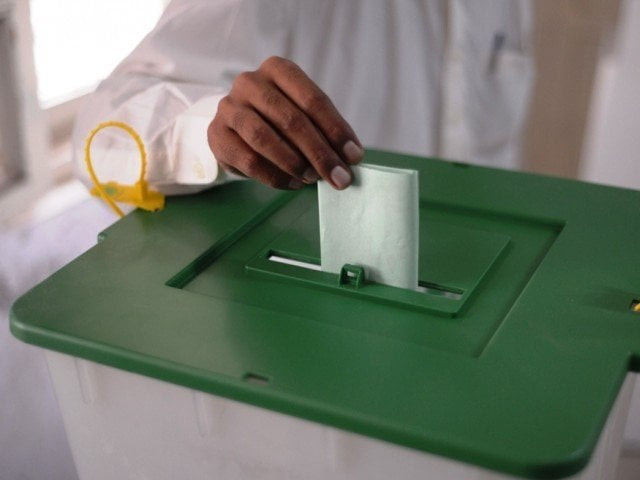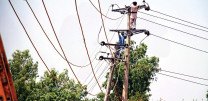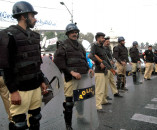Equality of vote compromised in 92 PA constituencies
'Discrepancies found in populations and registered voters within and across districts'

PHOTO: AFP
The report stated that the proposed constituencies deviate by more than 10% from their respective provincial average population as per the PA constituency, exceeding the ordinarily permissible variation range of 10% established by the law.
Out of the 92 PA constituencies there are 72 constituencies that have been suggested with a variation rate between 11% and 20% with nine constituencies indicating variation between 21% and 30%.
There are seven constituencies, which have a higher degree of variation between 31% and 40%, three constituencies have a variation between 41% and 50%. With regards to Balochistan, one constituency indicates an exorbitantly high variation at more than 50%.
FAFEN examined the variations found in the population and voter size of the Provincial Assembly (PA) constituencies with regards to the provincial and district averages of population and voters per constituency in a detailed analysis of proposed Provincial Assembly Constituencies in the Preliminary Report and List of Constituencies released by the Election Commission of Pakistan (ECP).
A comparative assessment of the proposed delimitations reveals lopsided inter-provincial and intra-provincial demarcations in the average population sizes of constituencies. For instance, the average population per PA constituency in Balochistan is 242,054 citizens, while the average population per constituency in Punjab is 370,307 citizens.
Similarly, districts do not fare equal with regards to population to PA seats ratio within the provinces. There has been a wide variation noted in the smallest and largest population-to-seat ratios of PA constituencies in all provinces.
For instance, PB-17 Jhall Magsi in Balochistan represents 149,225 citizens, while the population size of PB-24 Killa Abdullah-III is almost three times more than PB-17 with 407,323 citizens. This is a serious violation of the principle of equality of vote, since the voting power of a citizen in PB-24 is effectively three times less than half the voting power of his/her counterpart in PB-17.
In KP, the PK-35 Torghar constituency has been demarcated as a constituency with a population of 171,395 citizens, while PK-1 Chitral has a population of 447,362 – more than twice of the former's population size.
With regards to Punjab, the PP-273 Muzaffargarh-VI has been created with a population of 318,574 citizens, while PP-34 Gujrat-VII represents a much larger population size of 433,794 citizens. In Sindh, PS-77 Thatta-I has been allocated a population of 312,248 citizens, whereas PS-35 Naushehro Feroze-III will represent 429,980 citizens.
FAFEN's analysis also identified the discrepancies between population figures used for the NA constituencies and PA constituencies. The sum of the NA constituencies' population does not match the sum of the PA constituencies' population in at least four districts, including Dera Ghazi Khan, Lodhran and Muzaffargarh in Punjab and Abbottabad in KP.
The population of PA seats falling in Dera Ghazi Khan and Lodhran is more than the population of NA seats in these districts while the PA seats' population in Muzaffargarh is fewer than the NA seats population of the district.
Owing to these differences, as many as 90,550 citizens residing in these districts may potentially be disenfranchised from representation in the NA or PA. Similarly, in KP, there is a difference of 360 citizens between the total population assigned to NA seats and the population assigned to PA seats.
The disparities become more visible when ECP's voter statistics are applied on the proposed constituencies. If ECP's voter statistics updated in October 2017 are projected on fresh delimitation proposals, the constituency sizes vary between an average voter size of nearly 35,000 to more than 229,000.
FAFEN analysis of potential voting population of proposed constituencies suggests that 22 constituencies in Balochistan and one in KP will have less than 100,000 registered voters.
The averages of voters per PA constituencies vary greatly across provinces. In Balochistan, the average voting population per PA constituency is as low as 72,595 while in Punjab the average goes up to 187,948.
In the cases of Sindh and KP, the average voting population per PA constituency is 158,804 and 141,580 respectively. The district-wise averages of voting population per PA constituency present a more skewed picture of proposed delimitation.
For instance, in KP, Lower Dir district gets more seats than Abbottabad district despite less voting population as compared to the latter district. As many as five PA seats were allocated for 622,829 voters in Lower Dir and four for 774,134 voters of Abbottabad.
In Punjab, there are four PA seats proposed for more than one million voters of Chakwal district, whereas significantly lesser voting population of 813,576 in Rajanpur district has been given five PA seats.
In Sindh, the Tharparkar's 526,751 voters and Shaheed Benazirabad's 718,241 voters fare equal in Sindh PA with four seats allocated to each district. Moreover, Karachi West with a voting population of 1.6 million has been allocated 11 seats while Karachi Central with more than 1.7 million voters eight seats. In Balochistan, the Kech district has 22,087 fewer voters than Pishin district but got one more seat as compared to Pishin.
Majority of the PA constituencies in Balochistan will potentially have less than 100,000 voters while majority of Punjab constituencies will have a voting population of 150,001 to 200,000. The 22 PA constituencies in Balochistan and one in KP will potentially have an average voting population less than 100,000.
The 14 constituencies in Sindh, 13 in KP and six in Balochistan will have voters between 100,001 and 150,000. Similarly 25 districts in Punjab, 13 in Sindh and nine in KP – will have constituencies with voting populations averaging between 150,001 and 200,000 while 11 districts in Punjab and two each in KP and Sindh will get constituencies with a voting population more than 200,000.
Legally variation in population of constituencies of an Assembly should not ordinarily exceed ten percent as far as possible. However, FAFEN analysis reveals that variation exceeds the limit of ±10% in as many as 92 out of 575 PA constituencies which are being delimited in light of the Elections Act, 2017.
The Act allows ECP to deviate from this permissible limit in only exceptional cases; however, the reasons for any such deviation must be recorded in the Delimitation Order.
FAFEN recommends that the deviation from delimitation principle of capping the variation to ±10% should be taken seriously and it should be ensured that the citizen's right to equal representation is respected throughout the country.



















COMMENTS
Comments are moderated and generally will be posted if they are on-topic and not abusive.
For more information, please see our Comments FAQ